The Minervois
 The Minervois is an area situated between the Herault and the Aude and, like the Corbière, it is famous for its wine. Besides viniculture, the area is rich in history which goes back to before the Roman occupation.
The Minervois is an area situated between the Herault and the Aude and, like the Corbière, it is famous for its wine. Besides viniculture, the area is rich in history which goes back to before the Roman occupation. The name Minervois comes from the name Minerva, de Mother Goddess, who was introduced in the Languedoc by the Phoenicians and the Greek, who settled in the Languedoc's coastal strip several centuries BC. It is strange that the town which is called Minerve, is not situated in this department, but in the Herault.
The Minervois is a landscape with mild hills and flat land, and it can be very very hot in Summer. Traces from the past have become the present attractions and the Canal du Midi draws tourists who seek peace and quiet on the waters. The most important towns are Caunes-Minervois and Rieux-Minervois.
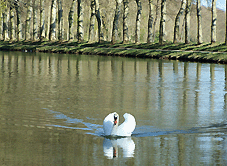 Le Canal du Midi
Le Canal du MidiTo avoid the dangerous sea route around Gibraltar (the infamous Gates of Hercules), there were already plans in Roman times to dig a channel and connect the Atlantic with the Mediterranean. Only much later this waterway was realized. The 240 km long Canal du Midi was dug in the 17th century and runs from Toulouse via Carcassonne and Narbonne to Sète on the Mediterranean coast. The project was executed under the leadership of Baron Riquest. There are over 100 locks to overcome the differences in height. To supply the higher parts of the canal with enough water, they built a great reservoir between Villefranche and Castelnaudary. The Canal du Midi is not suitable for ships bigger than 30 meters long and 1.60 meters deep. Today the Canal du Midi is more often used for relaxation than for commercial purposes. A small trip from Homps is especially recommended.
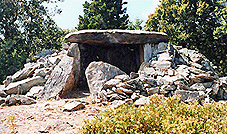 The Dolmens of Villeneuve
The Dolmens of VilleneuveFrom Villeneuve a narrow road leads to the at least 5000 year old dolmen "Palet de Roland". The town has created an access road on its own initiative, so that the ancient monuments can be accessible for all. In 1972, the monument was restored by a team of amateur archeologists. It was already very well preserved. Human remains have been found, along with pieces of flint stone.
Close to the dolmen lies the Tombe de Roland, a strange, incomplete tomb with a deep trench. Recent investigations discovered a piece of marble from the 17th century. It was probably a tomb, used for more people throughout the ages, from the 3rd century onwards. The burial gifts found on this spot include bronze and copper armlets and earthenware, which belong to these type of monuments. The top of the tomb is lost, so you can only see it's entrance and the burial chamber. The megalith is dominated by the remains of the farm with the same name. It looks as if the tomb, which was built millennia ago, was not built to be a tomb. It may just have been the remains of a rock from which an obelisk was cut out. The name given to the dolmens originate from a legend. Roland, the cousin of Charlemagne (9th century) would have worked on a sunstone, which he put on top of another stone. It was his wish to be buried close to this place. There are two walks to the monuments and there are information boards at the parking place.
Caunes-Minervois
This is a wonderful medieval town to stroll through. Its steep winding streets curl around the 8th century abbey. Many houses have gothic and Renaissance façades and others are even older. Upon the hill are the remains of a medieval castle. On its main road in the center of the town you can sit on a terrace and have a cold drink or a bite to eat.
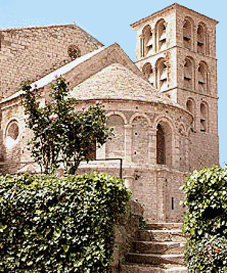 Caunes abbey was built in 780 by Anian and his friends, who soon became members of the Benedictine Order. The first abbey church was built between 806 and 820. In the 9th and 10th centuries, the abbey was prosperous. In 982, the remains of four people were found. These four people were martyrs from Roman times, when the first christians were still persecuted. They were Amand, Luce, Audalde and Alexander. Their remains are kept in the church as holy relics and the people of Caunes still hold processions in their honor through the streets of Caunes.
Caunes abbey was built in 780 by Anian and his friends, who soon became members of the Benedictine Order. The first abbey church was built between 806 and 820. In the 9th and 10th centuries, the abbey was prosperous. In 982, the remains of four people were found. These four people were martyrs from Roman times, when the first christians were still persecuted. They were Amand, Luce, Audalde and Alexander. Their remains are kept in the church as holy relics and the people of Caunes still hold processions in their honor through the streets of Caunes.During the crusade against the Cathars, also known as the Albigenzian crusade, the monks of Caunes remained loyal to the roman catholic church. In 1227, a Cathar bishop named Pierre Isarn was put on the stake in front of the abbey gate, to scare off other Cathars.
During the 15th century, the abbey was neglected. When the Religeous Wars between the protestants and catholics broke out, the Duke of Joyeuse took Caunes and built fortifications to defend the town.
In the early 17th century, Jean d'Alibert, who became the abbot of Caunes in 1598, restored the abbey and tried to make it prosperous once again. However, in 1695 the abbey was again neglected, which attracted the attention of the Benedictine Order, who renovated the abbey. In 1790, during the French Revolution, the buildings were badly damaged. There were only seven monks left in the abbey. Finally, Caunes abbey became state property. In 1916 the abbey church was declared a historic monument, followed by the abbey itself in 1948.
In the Middle Ages, Caunes was surrounded by an enormous wall with six gates: St. Genest, Notre Dame du Cros, Trausse, Hospital (of St. Jerome), Polister and Fountain. The wall and its gates barely survived the time and some pieces were built into the houses.
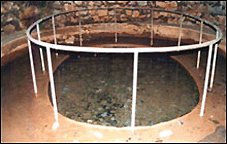 From Caunes you can visit one of the gates: Notre Dame du Cros. When you leave Caunes in the direction of Trausse, you will see it signposted to the left. When you follow this road you will arrive at a church, dedicated to Mary.
From Caunes you can visit one of the gates: Notre Dame du Cros. When you leave Caunes in the direction of Trausse, you will see it signposted to the left. When you follow this road you will arrive at a church, dedicated to Mary.Behind the church, below, you will discover an old Artemis or Minerva sanctuary cut out from the big rock. The reason why the sanctuary was built is the presence of a holy well. In early christianity, this site would have been dedicated to Mary Magdalene. In the Middle Ages, Mary Magdalene was replaced by Mother Mary and the Notre Dame churches in France which were originally dedicated to the Magdalen, were now dedicated to Mother Mary. Notre Dame means 'our Lady' and refers to the mother goddess, which would be Isis, Artemis or Minerve in Roman times.
Rieux Minervois
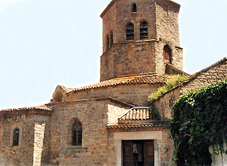 This former Bishop's Seat with several remains of its old city walls has a wonderful tourist information office. Close to the office is a peculiar heptangular church from the 12th century (drawing on the right), which is full of mysticism.
This former Bishop's Seat with several remains of its old city walls has a wonderful tourist information office. Close to the office is a peculiar heptangular church from the 12th century (drawing on the right), which is full of mysticism. It is clear that people who were aware of certain secrets of the region were involved in this church. But the lovely old church will probably never reveal her secrets. On the main road is a square with trees and a terrace. The Italian restaurant on the main road has delicious pizzas!